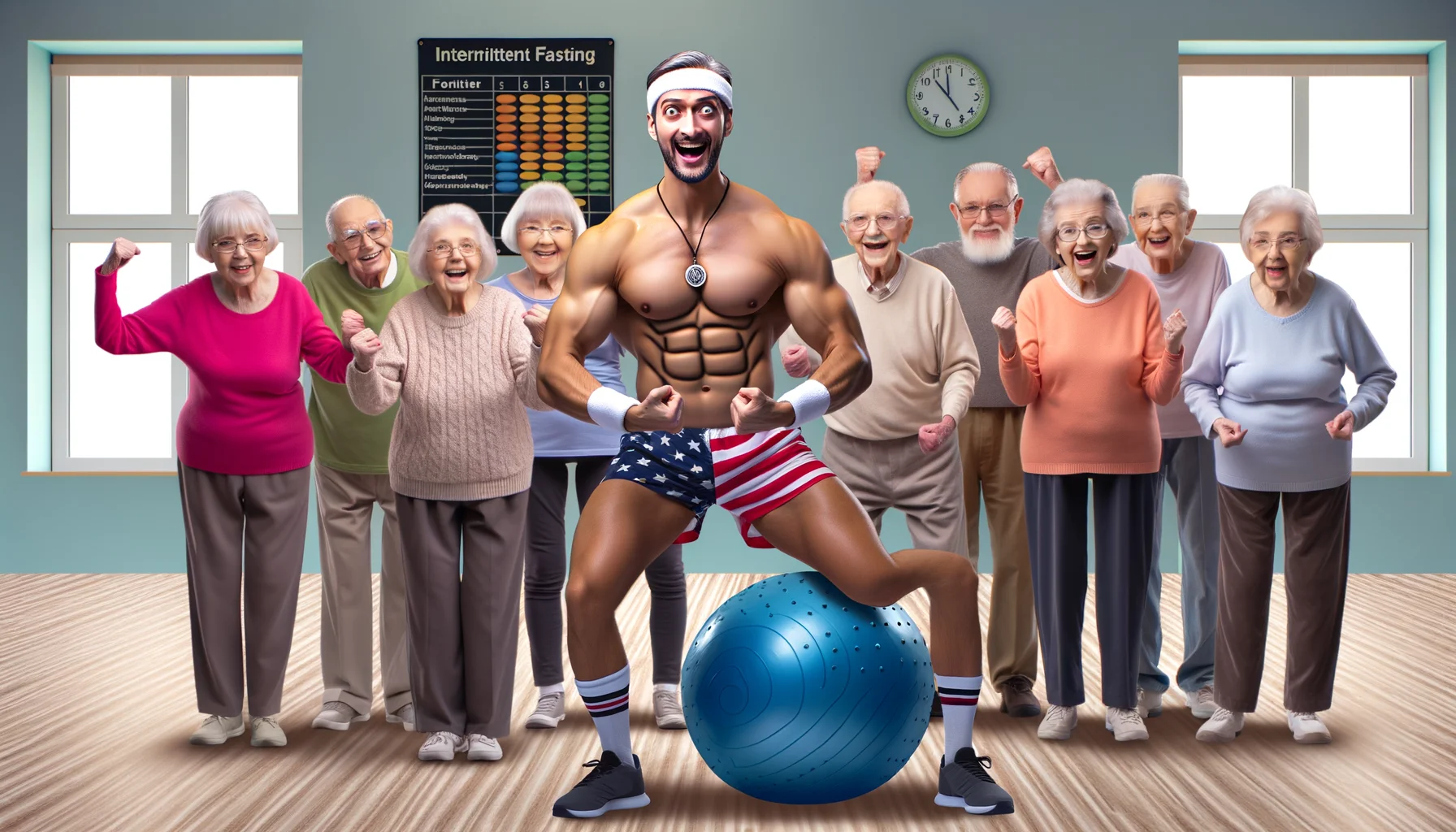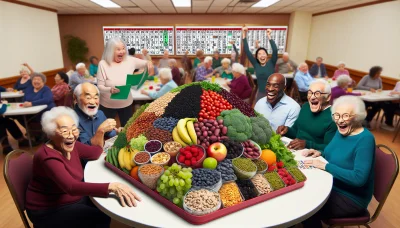Leangains martin berkhan Quiz
Test Your Knowledge
Question of
Understanding Leangains by Martin Berkhan
Principles of the Leangains Protocol
The Leangains protocol is a groundbreaking fitness regimen that combines intermittent fasting with weight training. Created by nutrition consultant and personal trainer Martin Berkhan, Leangains emphasizes a synergistic approach to diet and exercise, promoting fat loss while maintaining muscle mass.
At its core, the Leangains method revolves around an 8-hour eating window followed by a 16-hour fast. This pattern is designed to optimize the body's hormonal responses, improving metabolism and facilitating weight loss. The program also includes specific guidelines for pre- and post-workout nutrition to maximize performance and recovery.
Intermittent Fasting Schedule
The intermittent fasting schedule is a cornerstone of the Leangains model. It typically involves skipping breakfast and consuming all meals within an 8-hour period, such as from 12 pm to 8 pm. This fasting period helps regulate insulin levels and increases fat mobilization.
Adherence to the fasting schedule is crucial for success with Leangains. Its not just about calorie restriction but also about optimizing the timing of meals to align with natural circadian rhythms, thus enhancing overall health benefits.
Macronutrient Distribution
Leangains isn't just about when you eat; it's also about what you eat. Macronutrient distribution plays a significant role in this protocol, with specific recommendations for protein, carbohydrates, and fats based on workout days versus rest days.
- Workout Days: Higher carbohydrate intake, moderate protein, and lower fat.
- Rest Days: Higher fat intake, moderate protein, and lower carbohydrates.
Benefits of the Leangains Approach
Enhanced Fat Loss
The combination of intermittent fasting and targeted macronutrient intake makes Leangains exceptionally effective for fat loss. The fasting window increases lipolysisthe breakdown of fatswhile preserving lean body mass, leading to a more defined physique.
Fat loss with Leangains is not just about cutting calories but also about hormonal balance. The fasting-induced improvements in insulin sensitivity contribute significantly to shedding stubborn body fat without the dreaded weight loss plateaus.
Muscle Preservation and Growth
Maintaining muscle mass can be challenging during weight loss phases, but the Leangains approach excels at preservingand even buildingmuscle tissue. The high protein intake recommended by Berkhan supports muscle repair and growth.
In addition to dietary recommendations, strategic resistance training underpins the muscle-building aspect of Leangains. By focusing on heavy lifting during workouts, practitioners can expect not only to maintain but potentially increase their strength and muscle size while losing fat.
Starting Your Leangains Journey
Creating a Leangains Meal Plan
Embarking on your Leangains journey begins with crafting a well-structured meal plan tailored to your body's needs. It's crucial to strike a balance between macronutrientsproteins, fats, and carbohydratesto fuel both your workouts and recovery. Remember, consistency is key, so design a plan you can adhere to long-term.
Meal planning for Leangains should focus on whole, nutrient-dense foods that maximize muscle gain and fat loss. Prioritize lean proteins, complex carbs, and healthy fats to ensure each meal is a powerhouse of nutrition. Plan ahead to make your feeding window stress-free and enjoyable!
Calculating Your Caloric Needs
Understanding your daily caloric requirements is fundamental when following the Leangains protocol. Utilize online calculators or consult with a nutritionist to determine your Total Daily Energy Expenditure (TDEE). This will guide you in setting calorie goals for both training days and rest days.
When calculating calories, take into account your individual goals, whether its cutting fat or bulking up. Adjust your intake accordingly; eat in a slight surplus for muscle gain or deficit for fat loss. Monitor progress and be prepared to tweak your calories as your body changes.
Selecting Foods for Your Feeding Window
The quality of food in your feeding window profoundly affects the outcome of the Leangains method. Focus on high-protein foods like chicken breast, fish, legumes, and dairy products to support muscle synthesis. Complement these with fibrous vegetables and fruits for vital micronutrients.
- Proteins: Essential for muscle repair and growth; aim for lean sources such as poultry, fish, tofu, and eggs.
- Carbohydrates: Fuel workouts and recover with whole grains like oats, brown rice, quinoa, and starchy vegetables.
- Fats: Don't neglect healthy fats; include nuts, seeds, avocados, and olive oil for hormonal health and satiety.
- Veggies & Fruits: Pack in antioxidants with a variety of colorful produce; they're low in calories but high in fiber.
- Dairy: Opt for low-fat or full-fat versions based on your caloric needs; great source of calcium and additional protein.
Implementing the 16/8 Fasting Method
The 16/8 method is the cornerstone of the Leangains protocolfasting for 16 hours followed by an 8-hour eating window. It's vital to align this window with your daily routine for sustainable success. Most find skipping breakfast works best, but listen to your body's cues.
This fasting technique may enhance fat oxidation and improve metabolic health. Consistency with timing helps regulate hunger patterns and optimizes digestion during the feeding period. Be disciplined but flexible enough to adjust as needed based on lifestyle demands.
Timing Your Eating Periods
Selecting the right timing for eating periods can make all the difference in adherence to the 16/8 method. Typically, an eating window from noon to 8 PM suits most peoples schedules; however, you can adjust this according to work hours or workout times.
Your last meal should be well-balanced to sustain you through the fasting period. Including a good mix of protein, complex carbs, and fats will help manage overnight hunger pangs. Strategically time meals around workouts for maximum energy efficiency.
Managing Hunger During Fasting
Hunger management is crucial during the fasting phase of Leangains. Stay hydrated by drinking plenty of wateroften thirst is mistaken for hunger. Additionally, coffee or tea can be helpful appetite suppressants due to their caffeine content.
Mental preparation plays a significant role in overcoming hunger while fasting. Keep busy with tasks or hobbies that divert attention from food thoughts. With time, your body will adapt to the new eating pattern making hunger less intrusive on your day-to-day life.
Workout Strategies on Leangains
Resistance Training Recommendations
The backbone of any solid Leangains program revolves around resistance training. Prioritizing compound movements such as squats, deadlifts, and bench presses is essential for maximizing muscle growth and strength gains. These exercises engage multiple muscle groups, leading to more significant hormonal responses and functional strength increases.
Frequency is a crucial factor in resistance training within the Leangains framework. Training each major muscle group at least twice per week can promote optimal protein synthesis and recovery. This approach ensures consistent progress without overtraining.
Exercise Selection for Optimal Results
Selecting the right exercises on Leangains is pivotal for achieving your fitness goals. Emphasize movements that align with your objectives, whether it's hypertrophy, strength, or endurance. Incorporating a variety of exercises prevents plateaus by continuously challenging the muscles in new ways.
While focusing on compound lifts, don't neglect isolation exercises entirely. They complement the primary movements by targeting smaller muscle groups and addressing any imbalances. This holistic approach contributes to overall muscular development and symmetry.
Structuring Your Workout Routine
A well-structured workout routine on Leangains should be straightforward yet effective. Each session typically begins with one or two compound lifts followed by accessory work. This setup allows you to exert maximum effort on the main lifts when your energy levels are highest.
Rest intervals between sets are just as important as the exercises themselves. Shorter rest periods may benefit endurance and fat loss, while longer breaks can enhance strength and power output. Tailor your rest accordingly based on your current focus.
Cardiovascular Exercise and Leangains
Cardiovascular exercise is not the enemy of strength gains; it's a powerful ally when integrated correctly into the Leangains method. Strategic cardio can aid in fat loss without compromising muscle mass, especially when performed at a moderate intensity or utilizing high-intensity interval training (HIIT).
The type of cardio you choose should complement your lifting routine rather than compete with it. Activities like cycling or rowing can be beneficial as they have a lower impact on recovery compared to long-distance running.
Integrating Cardio into Your Regimen
- *Enumerative Lists: Used for itemizing elements, events, or tasks, often in a specific order. Ordered Lists: Sequence matters (e.g., procedural steps, rankings). Unordered Lists: Sequence does not matter (e.g., grocery lists, to-do lists). *Descriptive Lists: Each item is accompanied by additional details or a description. *Checklists: Designed for tracking completion or presence of items or tasks. *Multilevel Lists: Nested lists with items having sub-items. *Matrix Lists: Information presented in a two-dimensional grid or table format. *Priority Lists: Items are organized based on their importance or urgency. *Comparative Lists: Used for juxtaposing two or more items, options, or ideas.
Balancing Intensity and Duration
Balancing the intensity and duration of cardio sessions is crucial to reaping benefits without hindering recovery from resistance training. Shorter HIIT sessions can be incredibly effective for fat loss while preserving lean mass; whereas longer low-intensity steady-state (LISS) sessions may be better suited for active recovery days.
Your overall energy expenditure from cardio should align with your nutritional intake to maintain the fine balance required for body recomposition under Leangains protocol. Adjusting cardio based on dietary changes ensures consistent progress towards your physique goals.
Troubleshooting Common Challenges
Overcoming Weight Loss Plateaus
Hitting a weight loss plateau can be frustrating, but it's a common part of the journey. Your body adapts to your weight loss strategies, which means it's time to shake things up! A plateau signals that your current routine has become too comfortable for your body, and it's not being challenged enough to keep losing weight.
One effective way to break through a plateau is by reassessing your daily caloric intake. As you lose weight, your body requires fewer calories to function than it did at a heavier weight. Use a calorie calculator to determine your new caloric needs and adjust your intake accordingly. Be mindful of hidden calories in beverages and snacks that can add up without you noticing.
Adjusting Caloric Intake
Reducing calorie intake doesn't mean sacrificing satisfaction. Focus on nutrient-dense foods that are low in calories but high in vitamins and minerals. Incorporate more lean proteins, whole grains, and plenty of vegetables into your meals. These foods can help you feel full longer while keeping your calorie count in check.
Here's a tip: Keep a food diary or use an app to track everything you eat and drink. It will make you more aware of your habits and help you identify areas where you can cut back without feeling deprived.
Changing Exercise Variables
If your workouts have become routine, it's time to switch things up! Altering exercise variables such as intensity, duration, frequency, or type of exercise can reignite weight loss. Try adding high-intensity interval training (HIIT) sessions or incorporate new activities like swimming or cycling to challenge different muscle groups.
Muscle mass burns more calories at rest than fat does, so consider incorporating strength training into your routine. Lifting weights or using resistance bands can help build muscle, boost metabolism, and accelerate fat loss.
Dealing with Social and Lifestyle Obstacles
Social gatherings and travel often present challenges for those trying to maintain a healthy lifestyle. Peer pressure and the availability of tempting foods can derail even the most disciplined individuals. However, with the right strategies in place, you can navigate these situations successfully without compromising your goals.
To stay on track during social events, plan ahead! Eat a healthy snack before attending parties to avoid overindulging in high-calorie options. Choose smaller plates to control portion sizes and try to fill half of your plate with vegetables or salad.
Navigating Social Events
When attending social events, don't be afraid to bring your own healthy dish to share. This ensures there will be at least one nutritious option available to you. Also, be assertive about your dietary choices; friends and family are more likely to support you if they understand your goals.
- Stay hydrated by drinking water throughout the eventit'll help curb hunger and prevent mindless snacking.
- Position yourself away from buffet tables or appetizer trays to minimize temptation.
- If alcohol is involved, opt for lower-calorie options like light beer or wine spritzers.
- Engage in conversations away from the food table; socializing can distract from eating unnecessarily.
Maintaining Consistency While Traveling
Maintaining consistency while traveling is challenging but not impossible. Research restaurants and menus ahead of time so you can make informed meal choices when dining out. Look for accommodations with kitchenettes or at least a mini-fridge and microwave so you can prepare some meals yourself.
Pack portable workout equipment like resistance bands or jump ropes for easy exercise on-the-go. Even simple bodyweight exercises like push-ups, squats, and lunges can keep you active when away from home. Remember that staying active helps offset increased calorie intake from eating out more often while traveling.
Advanced Leangains Techniques
Optimizing Meal Timing and Frequency
Unlocking the full potential of the Leangains method requires meticulous meal timing and frequency. It's not just about what you eat, but also when you eat. Aligning your feeding window with an 8-hour period can amplify fat loss and muscle gains, making every calorie count.
To maximize results, structure your meals to fuel your body when it needs it most. Consuming the bulk of your calories in the post-workout period takes advantage of nutrient partitioning, driving growth and recovery. On rest days, consider reducing meal frequency to optimize fat burning.
Pre- and Post-Workout Nutrition
Pre-workout nutrition sets the stage for an epic training session. A small, protein-rich snack can prevent muscle breakdown and prime your body for muscle synthesis. Post-workout, it's crucial to hit that anabolic window with a meal high in protein and carbs to catalyze recovery and growth.
The post-workout meal is a powerhouse for progress; it's the perfect time to load up on nutrients that directly support muscle repair. Think lean proteins, wholesome carbs, and minimal fats to speed nutrients to your muscles when they're most receptive.
Eating Around Your Circadian Rhythm
Your circadian rhythm isn't just about sleepit plays a pivotal role in metabolism too. Eating in sync with your body's natural clock can enhance digestion and nutrient absorption. Aim to consume larger meals earlier in the day when insulin sensitivity is at its peak.
As evening approaches, our bodies are less equipped to handle large meals. By tapering off food intake as bedtime nears, you'll support better sleep quality and hormone regulationtwo underrated factors in achieving a lean physique.
Fine-Tuning Macronutrient Ratios
The magic of Leangains often lies in the precise balance of proteins, carbohydrates, and fats tailored to individual needs. High protein intake is non-negotiable for muscle preservation, but carbs and fats should be adjusted based on activity levels and personal preference.
A macronutrient strategy must be dynamic; it should evolve as you progress or hit plateaus. Regularly reassess your ratios to ensure they align with current performance goals or body composition shifts. This adaptability is key to long-term success with Leangains.
Tailoring Ratios to Training Demands
- Increase Carbohydrates: On heavy lifting days, scale up carb intake to refuel glycogen stores and power through workouts.
- Moderate Fats: While essential for hormonal health, keep fat lower on training days to make room for more carbs.
- Protein Consistency: Protein remains kingaim for consistent high intake every day to support muscle repair.
- Dial Back on Rest Days: With reduced energy expenditure, cut back slightly on carbs while maintaining protein levels.
- Listen to Your Body: Use biofeedback like energy levels and workout performance to fine-tune your intake as needed.
- Nutrient Timing: Post-workout is still prime time for carbsuse this window strategically for maximum benefit.
- Vary Sources: Diversify carb sources from fruits, vegetables, whole grains to legumes for a broad nutrient profile.
Comparing Diets: Leangains vs. Other Protocols
Leangains and the Ketogenic Diet
Similarities in Macronutrient Emphasis
Leangains and the ketogenic diet both place a strong emphasis on macronutrient management, but their approaches differ. Leangains focuses on a high protein intake with cyclic carbohydrate intake, tailoring nutrient consumption to workout schedules. The ketogenic diet also prioritizes macronutrients but emphasizes fats as the primary energy source, aiming to induce ketosis for weight loss.
Differences in Dietary Flexibility
The Leangains protocol offers more dietary flexibility compared to the ketogenic diet. It allows for controlled carb intake during specific periods, making it easier to maintain over time and more practical for those who enjoy a broader range of foods. In contrast, the ketogenic diet requires strict carb restriction, which can be challenging to adhere to and may lead to nutrient deficiencies if not managed carefully.
Leangains Versus Traditional Bodybuilding Diets
Meal Frequency and Size Comparisons
Traditional bodybuilding diets often recommend multiple small meals throughout the day to support metabolism and muscle growth. Leangains breaks this mold by promoting intermittent fasting and larger meals within a shorter eating window. This approach is not only convenient but also backed by research suggesting benefits for fat loss and muscle retention.
Impact on Metabolism and Muscle Growth
While traditional diets claim frequent meals boost metabolism, Leangains leverages intermittent fasting to potentially enhance growth hormone levels and improve body composition. The focus on heavy lifting during fed states ensures muscle growth is not compromised. In fact, many users report significant strength gains while following the Leangains method.
- Plan Your Eating Window: Align your eating window with your daily routine for sustainable adherence.
- Maintain Protein Intake: Prioritize protein to support muscle synthesis and satiety.
- Balanced Nutrient Timing: Time your carbs around workout sessions for optimal performance and recovery.
- Monitor Progress: Regularly track your progress to ensure you're meeting your fitness goals.
- Avoid Overeating: Despite larger meal sizes, be mindful of total caloric intake to prevent overconsumption.
- Fasting Discipline: Adhere strictly to your fasting schedule to maximize the benefits of the Leangains approach.
- Incorporate Strength Training: Combine the diet with heavy lifting workouts for synergistic effects on muscle growth.
- Stay Hydrated: Drink plenty of water especially during fasting periods to maintain hydration levels.
- Vary Your Foods: Keep a diverse diet within your macros to ensure micronutrient adequacy.
- Educate Yourself: Understand the principles behind Leangains to make informed dietary choices.
Success Stories and Case Studies
Transformations Achieved with Leangains
The Leangains method has revolutionized the fitness industry with its cutting-edge approach to intermittent fasting and strength training. Individuals from all walks of life have seen astounding physical transformations, shedding unwanted fat while gaining lean muscle mass. These success stories are not just about improved aesthetics but also about enhanced health markers and overall well-being.
Documenting Progress Over Time is crucial for anyone embarking on the Leangains journey. Success is often showcased through before-and-after photos, personal testimonials, and detailed workout logs. This documentation serves as a powerful motivational tool and provides a tangible record of the remarkable changes that occur through dedication to the Leangains protocol.
Analyzing Successful Strategies Used by Leangains enthusiasts reveals common threads in their approach to diet and exercise. Strategic calorie cycling, precise macronutrient targeting, and consistent strength training routines are among the core practices that drive these incredible body transformations. Understanding these strategies allows for replication and adaptation to individual needs.
Lessons Learned from Leangains Veterans
Adapting the Protocol Over the Long Term is a testament to the sustainability of the Leangains method. Veterans of this program emphasize the importance of flexibility and listening to one's body. They've learned that strict adherence to initial plans may not always be necessary as long-term success often requires periodic adjustments to dietary intake and workout intensity.
Key Takeaways for Newcomers can make all the difference in their journey towards achieving their fitness goals with Leangains. Seasoned practitioners advise starting with realistic expectations, focusing on form over weight in resistance training, and understanding that patience is key to seeing results. Moreover, they stress that it's not just about losing weight but about making a lifestyle change.
- Start Slow: Begin with manageable fasting windows and gradually increase as your body adapts.
- Maintain Balance: Ensure your diet includes a balance of proteins, fats, and carbohydrates tailored to your goals.
- Consistency is Key: Adhere to your training schedule consistently for optimal results.
- Track Your Progress: Use apps or journals to monitor your dietary intake and workout routines.
- Stay Hydrated: Drink plenty of water throughout the day, especially during fasting periods.
- Educate Yourself: Understand the science behind intermittent fasting and how it affects your body.
- Avoid Overtraining: Give your body adequate rest between workouts to recover and grow stronger.
- Seek Support: Connect with others following Leangains for motivation and advice.
- Tune Into Your Body: Make adjustments based on how you feel, energy levels, and progress towards your goals.
- Persistence Pays Off: Stay committed even when progress seems slow; transformation takes time.
Sustaining Progress with the Leangains Method
Adapting the Diet for Maintenance Phases
Once you've reached your weight goals, it's crucial to adapt your diet for maintenance. This means adjusting your caloric intake to match your new energy needs. The Leangains method isn't just about fat loss; it's a sustainable approach to maintaining your physique.
Maintaining your progress requires a careful balance of macronutrients. While you may have followed a strict protocol to shed pounds, the maintenance phase allows for more flexibility. Listen to your body and adjust portions as needed to maintain your weight.
Modifying Caloric Intake for Stability
To prevent weight regain, caloric intake should be modified for stability. This involves calculating your Total Daily Energy Expenditure (TDEE) and consuming calories close to this number. Keep monitoring your weight and make small adjustments as required.
Remember that activity levels can fluctuate, affecting calorie requirements. Stay active and continue with resistance training while adjusting your caloric intake to align with these changes. Consistency is key in the maintenance phase.
Shifting Focus from Cutting to Maintaining
The shift from cutting to maintaining is both a mental and physical transition. Focus on the long-term habit of eating balanced meals rather than the short-term goal of losing weight. This mindset will help sustain your achievements with the Leangains method.
Introduce more variety into your diet to keep things interesting while maintaining nutritional balance. A diverse diet can also help prevent micronutrient deficiencies as you move away from stricter cutting phases.
Long-Term Health Considerations
The Leangains method isn't only about looking good; it's also about feeling great and staying healthy over time. Ensuring long-term health requires attention to both macro and micronutrients in your diet, as well as regular physical check-ups.
Avoid complacency by continuing to educate yourself on nutritional science and health trends. Staying informed will help you make adjustments to the Leangains method that benefit your health in the long run.
Ensuring Nutritional Adequacy
- Maintain a balanced intake of proteins, carbohydrates, and fats to support bodily functions.
- Incorporate a variety of fruits and vegetables for essential vitamins and minerals.
- Consider supplementation if dietary sources do not meet all nutrient requirements.
- Stay hydrated by drinking plenty of water throughout the day.
- Avoid overly restrictive diets that may lead to nutrient deficiencies over time.
- Regularly review and adjust food choices based on changes in health or activity levels.
Monitoring Biomarkers of Health
Biomarkers such as blood pressure, cholesterol levels, blood sugar, and others are critical indicators of health. Regular monitoring can provide insights into how well the Leangains method is working for you holistically.
Work closely with healthcare professionals to track these biomarkers. They can offer invaluable guidance on how to adjust your diet and exercise regimen for optimal health outcomes. Remember, prevention is better than cure!












